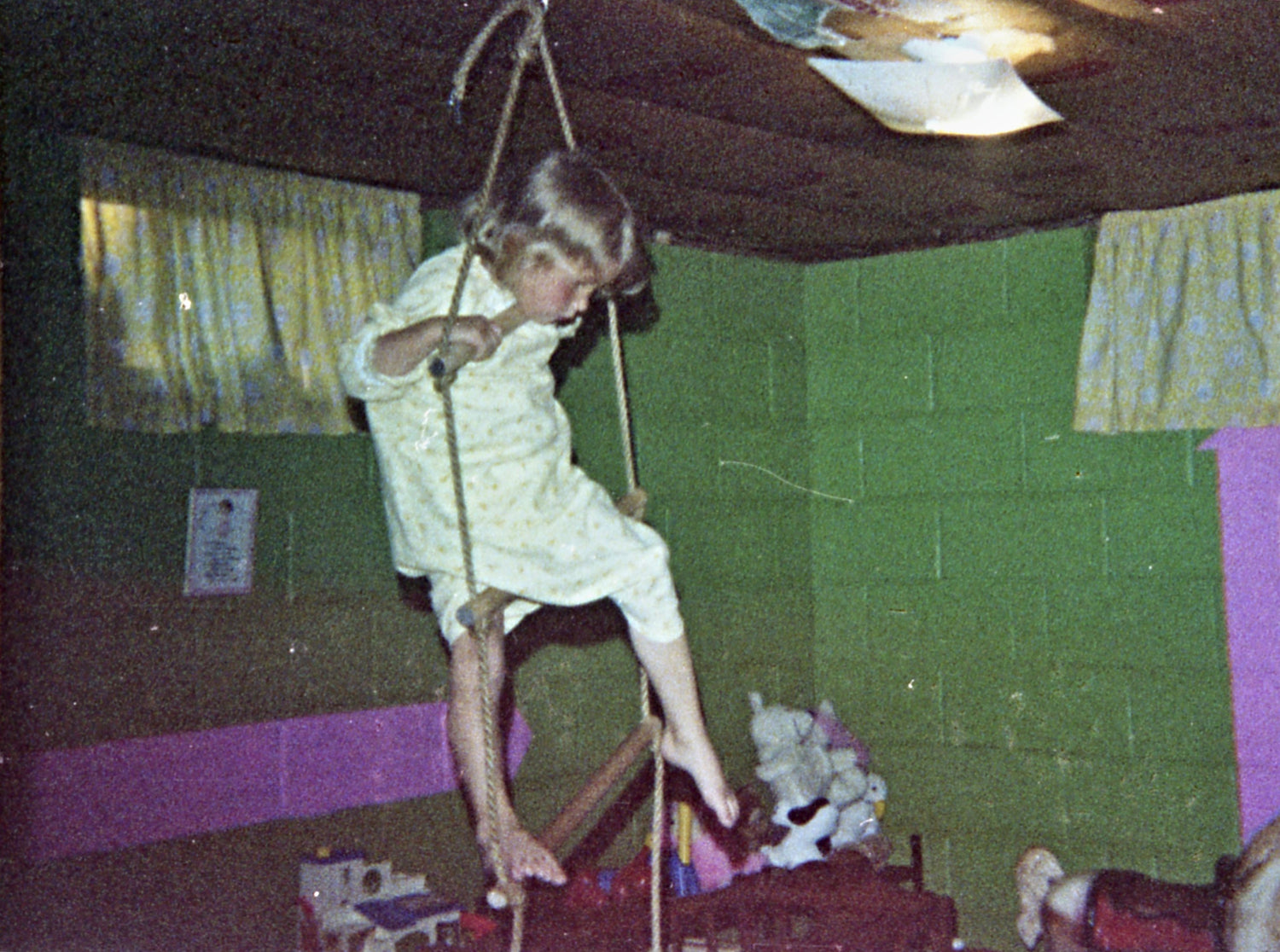This is me at about age 5, circa 1980, climbing a rope ladder in my nightgown.
This is a Move Your DNA (Katy Bowman) podcast from a few weeks ago called “Movement as Regulation: Spicy Kids” that has been on my mind.
“Neurodivergent” is a non-clinical term for people whose brains function differently from what is considered “normal.” Of course, there’s a whole discussion about what determines “normal”, but that’s for another day. In this case, I am talking about people who have autism, anxiety, ADHD, OCD, or a number of other diagnoses that fall under the neurodivergent umbrella. “Neurospicy” is another word for neurodivergence that is commonly adopted by those with differing experiences, which is why Katy uses the term “spicy” in her podcast.
There is more information today about helping neurodivergent kids regulate their bodies. When we ran our Stoic standing mat campaign, we heard from many parents of sensory-seeking neurodivergent kids, which was awesome! One thing I rarely hear discussed, however, is the fact that neurodivergent kids become neurodivergent adults.
I was a spicy kid, but in the 80s, no one knew anything about neurotypes. I was pretty quiet and kept to myself because I didn’t like getting in trouble. But I also had a lot of energy. I snuck Lego figures to school in my pockets so I had something to fidget with during class. I chewed on erasers, picked my fingernails, and bounced my legs until my desk shook. I still do any time I have to sit in one position for more than a half hour. Thankfully, when I was growing up, school kids still got solid gym and recess time. We had recess before school started and after lunch and gym class every day.
Our school had an old metal playground with monkey bars that were 6+ feet off the ground. As long as we weren’t hitting each other, the playground supervisors let us play however we wanted. We walked across the top of the monkey bars, hung upside down by our knees and swung until we could flip off to land on our feet. We jumped from the top of the monkey bars to catch the high bar on the other side of the playset. In gym class, we climbed ropes, played dodgeball, and jumped on pogo sticks. Then I’d get home from school and play outside with neighborhood kids until dinner time (and sometimes after, too).
All of that activity kept me sane in school because it helped me to regulate the hyperactivity and restlessness in my mind and body. I only started understanding how vital movement truly is for me in the last few years. Even with so much activity, I often couldn’t fall asleep at night. I would do somersaults and jump on my bed, get on the floor and do calisthenics, or rearrange my furniture. I’d hear my mom coming down the hall to check on me and I’d pretend to be asleep, then get right back out of bed after she left. 40 years later, I still don’t sleep well if I don’t get enough exercise during the day.
What does it mean to be regulated versus dysregulated? It can be different for everyone. For me, being dysregulated means that I am easily overwhelmed by small stuff, my mind is racing with numerous streams of thought about different, unrelated topics. I feel restless in my body where if I can’t be moving I want to crawl out of my skin. If you’ve ever had restless legs where you get a sensation that makes you have to move your legs around, it’s like that, but my whole body. I tend to be hyposensitive to input around me, meaning I need more sensory and activity input in order to feel normal. Other people are hypersensitive, meaning they need to reduce their sensory and activity input to feel normal.
Exercise regulates me better than anything else. It’s similar to the relief of finally scratching a massive itch that you previously couldn’t reach. I always want to do more, harder, and for longer. I almost joined the military because boot camp sounded like fun. Katrin Davidsdottir (an elite Crossfitter) said: “Nothing makes me happier than hard work. I literally love when the workout gets hard and starts to hurt. The cue that tells others to take their foot off the gas pedal is my cue to go faster. At night I fall into my bed, exhausted. I love it.” Heck yes! That’s exactly how I feel.
The bottom line is, when I get dysregulated or stressed, I need to move! But I don’t always have time for a hard workout. Other things help, too. I’ll go outside and walk barefoot backward up and down the hill in our yard. Why backward? Concentrating on a different movement pattern gives my brain something new to focus on. Or I stand on the Warrior Stoic mats and really dig my feet in and do some moves on the pocket monkii at the same time. Time in the hot tub or a long drive with loud music blasting can also help.
Practicing regulation decreases my mental hyperactivity, restlessness, and overwhelm. It calms my body, slows my thoughts, and brings me back to a level where I am more resilient to life's demands. Exercise happens to be the best solution for me and it works as a preventative as well. Days that start with movement always go better overall.
The bottom line is, when I get dysregulated or stressed, I need to move! But I don’t always have time for a hard workout. Other things help, too. I’ll go outside and walk barefoot backward up and down the hill in our yard. Why backward? Concentrating on a different movement pattern gives my brain something new to focus on. Or I stand on the Warrior Stoic mats and really dig my feet in and do some moves on the pocket monkii at the same time. Time in the hot tub or a long drive with loud music blasting can also help.
Practicing regulation decreases my mental hyperactivity, restlessness, and overwhelm. It calms my body, slows my thoughts, and brings me back to a level where I am more resilient to life's demands. Exercise happens to be the best solution for me and it works as a preventative as well. Days that start with movement always go better overall.
As I continue my hip replacement recovery, I’m doing 4 days of strength training per week. In normal times, I do 6 days a week of strength training and day 7 is an adventure day. When I wake up in the morning, the first thought I have is “Is today a workout day?” and these days I’m a bit disappointed to encounter rest days. Nothing else has the same impact on me as doing hard workouts or challenges like rucking hills, snowshoeing in deep snow, or long, rugged hikes. Those are the types of things that help me to regulate my restless mind and body. As a result, getting enough movement has been a challenge in my recovery and I’ve had more trouble sleeping and staying focused. But it improves week-to-week!
Movement as regulation isn’t just for neurodivergent kids. Those same kids will grow up to be adults who are partners, parents, friends, and co-workers. They will have similar needs but often end up falling into unhealthy coping strategies like drinking or doom scrolling social media. Many of us are already adults, we just never had names for our experiences when we were younger. Movement doesn’t help everyone, some people need the exact opposite, or they need different kinds of movements. Many neurospicy people like to jump, for example. A trampoline can be a great option!. The key is to figure out what you need so it can be recognized before dysregulation goes too far and gets harder to manage.
If you’ve got a neurospicy kid, they can be challenging! They often have no fear and in an attempt to regulate themselves, they take big risks. I was a calculated risk taker myself, but I have a spicy risk-taking kid and he keeps me on my toes even though he’s grown up now. Helping them learn how to regulate that energy safely is important. There are risks that can be taken properly to provide the input they are looking so hard for and can’t get in typical ways, especially as movement time has been reduced in school over the years. They also need to be allowed to trust their bodies. As a parent, you might cringe at the thought of your kid walking across the monkey bars or jumping higher than the roof on a trampoline. But they likely need that much input in order to feel normal. Finding safe ways to do so is vital and there are more options than ever today like trampoline parks, gymnastics programs, and even Ninja/parkour gyms.
Whether you are neurodivergent yourself, know someone who is, or maybe you just relate to mental and physical restlessness, exercise can be one way to help slow things down so you can get through the necessary functions of your day.
Stay spicy out there!
-Kim


Leave a comment
This site is protected by hCaptcha and the hCaptcha Privacy Policy and Terms of Service apply.